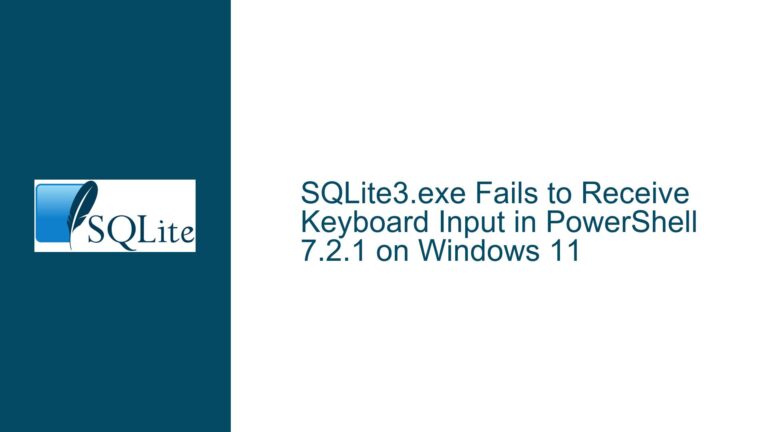Resolving SQLite Database Connection Failures and DataGridView Display Issues in VB.NET WinForms
Issue Overview: Failed Database Connection and Empty DataGridView in VB.NET Application
The core problem revolves around a VB.NET WinForms application failing to establish a connection to an SQLite database and display data in a DataGridView control. The user has followed standard setup steps, including installing the System.Data.SQLite NuGet package, configuring a connection string in application settings, and writing code to load data into the grid. However, the application produces no errors but fails to populate the DataGridView, displaying only column headers. Two compiler warnings are also present: an unused SQLiteDataReader variable and a potential null reference exception when closing the connection.
Key symptoms include:
- Silent Connection Failure: The application compiles and runs without runtime errors, but the database is not accessed (no data appears in the UI).
- Incomplete Error Handling: The
Try...Catchblock swallows exceptions, making it difficult to diagnose why the connection or query failed. - Misconfigured Data Binding: The
DataGridViewcolumns are pre-defined, but the automatic column generation feature might conflict with manual configurations. - Compiler Warnings: The unused
rdrvariable and uninitializedcnvariable hint at structural issues in the code logic.
The root cause is likely a combination of an invalid connection string, misconfigured SQLite dependencies, and improper error handling. Secondary issues include inconsistencies between manual DataGridView column definitions and the schema of the returned data.
Possible Causes: Connection String Errors, Data Binding Misconfigurations, and Resource Leaks
1. Invalid or Misplaced Connection String
- Path Resolution: The connection string
"data source=mydata.db;"assumes the database filemydata.dbis located in the application’s working directory (e.g.,bin\Debugorbin\Release). If the file is misplaced or the path is not absolute, SQLite may silently create an empty database or fail to connect. - File Permissions: The application might lack read/write permissions for the database file, especially if it’s located in a protected directory like
Program Files. - Version Mismatch: Omitting
Version=3;in the connection string can cause compatibility issues with newer SQLite engines.
2. Unhandled Exceptions or Silent Failures
- The
Catchblock usesMsgBox(ex.Message), which might not display critical errors if the UI thread is frozen or the exception is non-fatal. Additionally, theFinallyblock attempts to close a connection (cn.Close()) that may never have been opened, triggering the "variable used before assignment" warning.
3. Data Binding Conflicts in DataGridView
- Manually added
DataGridViewcolumns may conflict with auto-generated columns from theDataTablebinding. If theAutoGenerateColumnsproperty isTrue, the grid might create duplicate columns or override manual configurations.
4. SQLite Binary Mismatch
- The
System.Data.SQLiteNuGet package (version 1.0.117) might not align with the SQLite engine (3.40.1). Mixed 32-bit and 64-bit binaries can causeBadImageFormatExceptionerrors, though these are often masked by generic exception handling.
5. Database File Corruption or Schema Mismatch
- The database file might be corrupted, or the table name in the SQL query (
select * from employees;) might not match the actual schema (case sensitivity, typos, or missing tables).
Troubleshooting Steps, Solutions & Fixes
Step 1: Validate the Connection String and Database Location
- Use Absolute Paths:
Replace"data source=mydata.db;"with an absolute path:cn = New SQLiteConnection("Data Source=C:\Full\Path\To\mydata.db;Version=3;")To avoid hardcoding, retrieve the path dynamically:
Dim dbPath As String = Path.Combine(Application.StartupPath, "mydata.db") cn = New SQLiteConnection($"Data Source={dbPath};Version=3;") - Verify File Existence:
Add a pre-check to ensure the database exists:If Not File.Exists(dbPath) Then MsgBox($"Database file not found: {dbPath}") Return End If - Test with Chinook.db:
Download the Chinook sample database, unblock the file (right-click > Properties > Unblock), and update the connection string to point to this file. If the sample works, the issue lies with the original database or its schema.
Step 2: Improve Error Handling and Debugging
- Log Detailed Exceptions:
Modify theCatchblock to log the full stack trace:Catch ex As Exception MsgBox($"Error: {ex.Message}" & vbCrLf & ex.StackTrace) - Step Through Code with Debugger:
UseF11to debug line-by-line. Check ifcn.Open()throws an exception or ifcmd.ExecuteReaderreturns no rows. - Verify Connection State:
After opening the connection, validate its state:cn.Open() If cn.State <> ConnectionState.Open Then MsgBox("Connection failed to open.") End If
Step 3: Resolve DataGridView Binding Issues
- Disable Auto-Generated Columns:
SetAutoGenerateColumns = Falseon theDataGridViewto prevent conflicts with manual columns:DataGridView1.AutoGenerateColumns = False - Map Columns Manually:
Ensure eachDataGridViewColumnhas itsDataPropertyNameset to the corresponding database column name:Dim colId As New DataGridViewTextBoxColumn() colId.HeaderText = "Employee ID" colId.DataPropertyName = "EmployeeId" // Must match the SQL result column name DataGridView1.Columns.Add(colId) - Test with a Simple Query:
Replaceselect * from employeeswith a hardcoded query to isolate schema issues:cmd = New SQLiteCommand("SELECT 'Test' AS Column1, 123 AS Column2;", cn)If "Test" and 123 appear in the grid, the original SQL query is invalid.
Step 4: Fix Compiler Warnings and Resource Leaks
- Remove Unused Variables:
Delete the unusedrdrvariable to eliminate the warning:// Remove this line Dim rdr As SQLiteDataReader - Initialize the Connection Properly:
UseUsingblocks to ensure resources are disposed:Try Using cn As New SQLiteConnection("Data Source=...") cn.Open() Using cmd As New SQLiteCommand("SELECT * FROM employees;", cn) Dim dt As New DataTable() dt.Load(cmd.ExecuteReader()) DataGridView1.DataSource = dt End Using End Using Catch ex As Exception MsgBox(ex.Message) End TryThis eliminates the
Finallyblock and guarantees the connection is closed.
Step 5: Diagnose SQLite Engine and Binary Issues
- Match SQLite Engine Versions:
Ensure theSystem.Data.SQLitepackage matches the architecture (x86/x64) of your project. For a 64-bit app, use the "x64" NuGet package. - Enable Mixed Platform Debugging:
In Visual Studio, go to Project Properties > Debug > Enable "Use the 64-bit version of IIS Express for web sites and projects" if targeting 64-bit SQLite.
Step 6: Advanced Diagnostics
- Use SQLite Command-Line Shell:
Verify the database integrity:sqlite3 mydata.db "PRAGMA integrity_check;" - Check Foreign Key Constraints:
Enable foreign keys in the connection string to detect schema issues:cn = New SQLiteConnection("Data Source=...;Foreign Keys=True;")
By methodically addressing connection strings, error handling, data binding, and compiler warnings, developers can resolve SQLite integration issues in VB.NET WinForms applications. Always start with a known-good sample (e.g., Chinook.db) to isolate environmental factors before troubleshooting custom databases.






